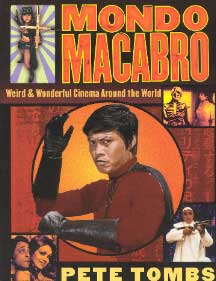Chocolate: This film {
more details} has me moderately interested (despite the presence of Sun
iel Shetty). A burning question is: how many
Chocolates are there? There's
this telefilm shot in Switzerland and Germany with a plot that stinks of
Paanch-ness. And is this the same Vivek Agnihotri? And the vibes of
The Usual Suspects (whose evisceration had already begun with
Kaante) are undeniable. On with the soundtrack delivered by Pritam (who also did
Raghu Romeo and hit the big time with
Dhoom). All the songs are laced with decent melodies and rich arrangements. They make for good background material. But there's a lot of fun to be had listening to the lyrics. We open with
halakaa halakaa which opens with a nice sample of a needle scratching on a gramophone record. What's hilarious on this track is not Sonu Nigam, but the rap talk peppered throughout (the usual "yeah" along with phrases like "check this out" and such) along with a chorus crooning away. Enjoyable. The remix reuses a lot of the samples on Pritam's big hit
dhuum machaa le. K K hits the highs with aplomb on a dance hall-friendly
zahariilii raate.n. Familiar beat, familiar samples, familiar everything (Krishna's version of
rabbaa on
Musafir comes to mind). Remember Jal-man
Atif Aslam? (how about
vo lamhe.n?). Take the DJ mix of the song that featured on the
Zeher and add
ab to aadat sii hai. Shame, Pritam, Shame!! Liked the use of an electronically processed voice ever so slightly near the ends of the lines in the a.ntaraa. Sunidhi Chauhan and Kailash Kher make
jhukii jhukii a joy to listen to. The Roxette-ish opening, the indecipherable chorus fragments. And yet again, someone is reminded of an NFAK song. I need to check all this up. Kunal Ganjawala does well on
panaaho.n me.n which opens hinging on a short guitar riff before the beats and good old rap ("yeah", "that's right") kick in. There's more chorus too (and this time it's a chorus/rap jugalaba.ndii).
bhiigaa bhiigaa starts off with some more ooh-baby male jabber from Indi (not unfamiliar to us here in the US who watch TV and are pelted with hip-hop/soul videos dedicated to condescendingly lauding different aspects of the female form -- one in particular, and sometimes the other two). Sunidhi does a good job, but it's time someone gave her something more meaningful to sing. Why does a great voice like this have to just do songs like this? Kunal Ganjawala returns with Suzanne D'Mello (who?) return with
Kalish sii hai. There's the nice Dire Straits/Floyd-ian opening guitar; some sobbing; and then the vocal kicks in. Predictable rise and fall on the melody reusing most of the conventions of radio-friendly rock. The song ends with a sample of chirping birds (leftover vibes from
The Wall?).
The theme of the movie begins with a female voice that intones words (rescue me; somebody save me from this pain and sorrow; save me [??]) and with her ebb, the chorus kicks in, she returns with a rescue me, the chorus oh-s in, she fades out, and the chorus goes Chocolate. The beats and samples kick in. Yeah. Nice for the titles. But I don't see much sequitur in a plea for help and Chocolate (yeah yeah I know it's slang for illegal maal). More words exchanged in tandem with a guitar riff. Pounding away. Later on in the song, a male voice interjects with laughter. And then he begins to speak (in purely exaggerated fashion): maybe you misunderstood / it's all bad, there is no good; your eyes reflect death; your heart is cold with sweat; your body trembles with hate; your chocolate decides people's fate. Poetic. More pounding riff-and-rhythm. And who can deny the chorus from going Chalk-chalk-chalk-chalk-chocolate near the end.
All this brings me to the most howlarious (lyrically) number on the album. This one might go right up there with mai.n yaar pa.njaabii jaT. The saddest thing is that both have Sunidhi Chauhan warbling nonsense. Could someone please rescue her before I start liking her singing for different reasons (B-potential instead of sheer talent)? *Wipes a tear* So the song's kinda trying to capture the idea of this girl who's havin' a good time 'round town, but her momma kinda doesn't like know about it. So after all the screaming, sampling and pa.njaabii-tinged choral exultation, SC begins: kahate hai.n sabhii ki ba.Dii ##hot huu.N mai.n; ##tell you what tequila## kaa ik ##shot## huu.N mai.n; magar Kayaal ye rahe zaraa; ##mummy## ko nahii.n hai pataa; ##mummy## ko nahii.n hai pataa; ##so mummy## se naa kahanaa. Time for convulsions.
James: Another forthcoming flick from RGV's
factory. This one's apparently a complete masala flick. The soundtrack features songs that are heavy with the dance beat and samples. Another multi-composer effort this, and it also marks Nitin Raikwar's growth in the camp on the composing front. Shweta Pandit presents another of Raikwar's stabs at the muse called
zi.ndagii. This one's called
zi.ndagii jiine kaa naam. A nice dose of energy (and I kinda relished the false "end" before the final string run). If you're a melody freak you won't much here to be excited about. If you like arrangements, this is at least listenable. Sunidhi Chauhan steps up with
Hero intoning the title at several points in this lyrically bland effort. D-man Prasanna Shekhar is responsible for the music this time. The strangest part about this song is how much the muKa.Daa is reminiscent of the melody of the a.ntaraa of RDB's
ye din to aataa hai from
Mahaan (and the off-beat percussion is an almost direct lift). Loved the calm broken by that synthesizer riff. Aside from that, just hearing
James occasionally is a bit corny. The next track I caught off this soundtrack was the Nigam/Ghoshal duet
mai.n gussaa huu.N. The arrangements appealed to me, but I'm not going to the rooftops yet. Nigam returns with Shweta Pandit for the Bapi-Tutul tuned
si.nduurii aasamaan.
addendum [august 06, 2005]: How many times have they warned you against doing your own research and wasting the efforts that others have taken? Bad boy! Karthik @
I2FS [now ItwoFS] has done some background digging into the nefarious efforts of Sir Pritam on this soundtrack. The results are in his July 31, 2005 entry [no direct link, and the information might soon move to the
Others page -- unless dear Pritam does enough to qualify for a page of his own like Anu Malik]. In addition to all the lifts I noted above, even
bhiigaa bhiigaa saa is a straight (read melody and lyrics) lift from an Abrar Ul Haq (see: the much better state of affairs for the Pakistani pop scene while India produces goat goo) song called
December [
bhiigaa bhiigaa saa ye ##december## hai ...]. Wasn't Abrar the guy responsible for
bilo de ghar which became the Sen concoction
kammo! (trivia alert: voiced by Lalit Sen) in
Ziddi?? Aw gawd! To quote Harlan Ellison from
The place with no name, it's time to go screaming "like the Doppler effect of a train whistle as it fades past a fixed point".

 Yours Truly was back at the library. Having deposited a few returns, YT proceeded to the shelves browsing. YT knew there were holds. But this was the second part of the visit: Impulse shopping, without the purchase. YT spots
Yours Truly was back at the library. Having deposited a few returns, YT proceeded to the shelves browsing. YT knew there were holds. But this was the second part of the visit: Impulse shopping, without the purchase. YT spots 
 The same applies to
The same applies to 


